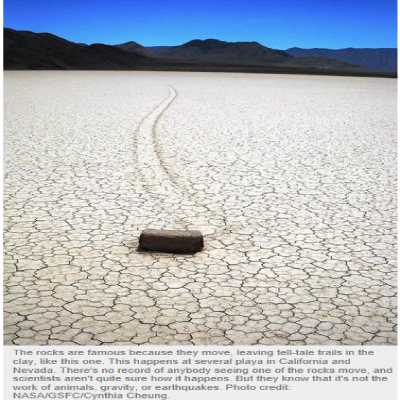
 Racetrack Playa, and several other playas in California and Nevada contain rocks standing on the dry mud and apparent tracks indicating that these rocks moved hundreds of feet. The rocks range from a few pounds to over 700 pounds with most being in the 25-30 pound range.
Racetrack Playa, and several other playas in California and Nevada contain rocks standing on the dry mud and apparent tracks indicating that these rocks moved hundreds of feet. The rocks range from a few pounds to over 700 pounds with most being in the 25-30 pound range.
How did these rocks move? That has been the question asked since at least 1940s when investigations began. Most explanations involve wind, water, or ice, but nobody has seen the rocks move – until now.
A new paper, “Sliding Rocks on Racetrack Playa, Death Valley National Park: First Observation of Rocks in Motion” published August 27, 2014 provides an answer.
In a study funded by NASA, researchers established a remote weather station on the playa, set up time-lapse cameras, and glued GPS transmitters to some of the rocks.
The paper abstract reads:
“The engraved trails of rocks on the nearly flat, dry mud surface of Racetrack Playa, Death Valley National Park, have excited speculation about the movement mechanism since the 1940s. Rock movement has been variously attributed to high winds, liquid water, ice, or ice flotation, but has not been previously observed in action. We recorded the first direct scientific observation of rock movements using GPS-instrumented rocks and photography, in conjunction with a weather station and time-lapse cameras. The largest observed rock movement involved more than 60 rocks on December 20, 2013 and some instrumented rocks moved up to 224 meters between December 2013 and January 2014 in multiple move events. In contrast with previous hypotheses of powerful winds or thick ice floating rocks off the playa surface, the process of rock movement that we have observed occurs when the thin, 3- to 6 millimeter, ‘windowpane’ ice sheet covering the playa pool begins to melt in late morning sun and breaks up under light winds of ~4–5 meters/second. Floating ice panels 10s of meters in size push multiple rocks at low speeds of 2–5 meters/minute along trajectories determined by the direction and velocity of the wind as well as that of the water flowing under the ice.”
You can read the full paper at:
http://www.plosone.org/article/info%3Adoi%2F10.1371%2Fjournal.pone.0105948
